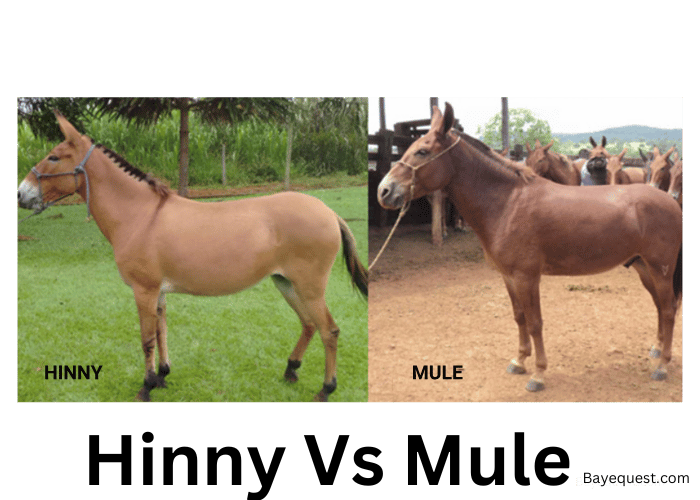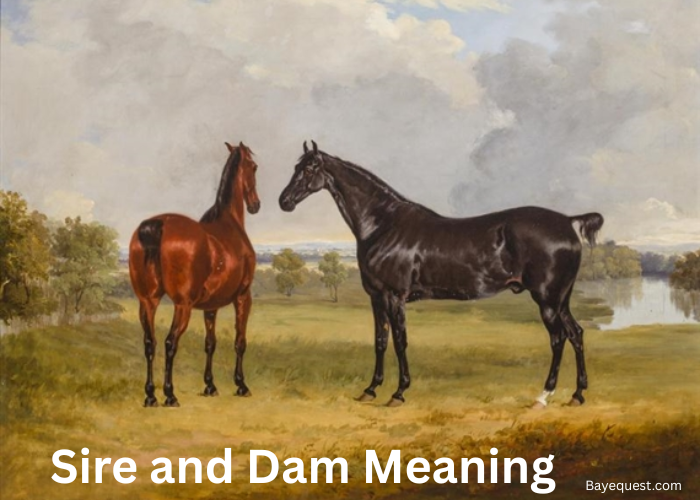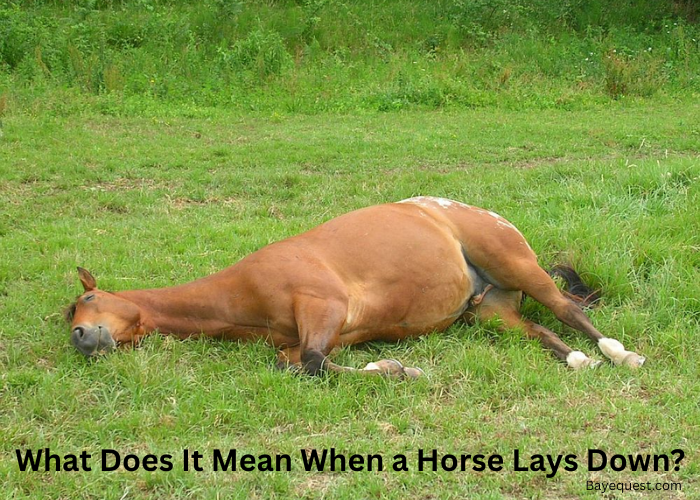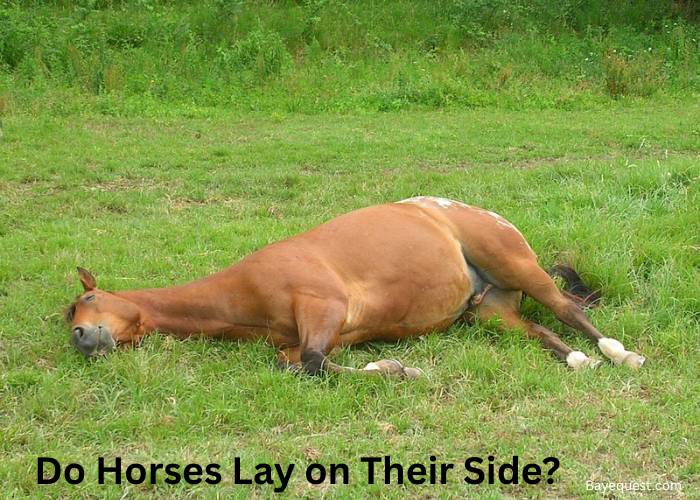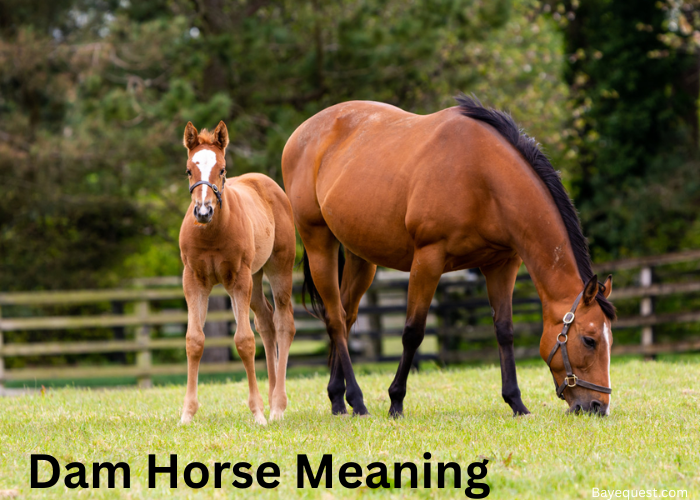Hinnies and mules come from horse-donkey pairings, but did you know they’re not the same? The differences might surprise you.
As an equine enthusiast, I know how confusing these horse donkey hybrids can be. If you’re unsure which one suits your needs, you’re not alone.
This guide will break it all down—traits, uses, and care. You’ll see why picking the right hybrid makes all the difference.
Ready to dive in?
Hinny Vs Mule: Key Takeaway
A hinny is a hybrid of a stallion and a jenny, often smaller with horse-like traits. A mule, from a mare and a jack, has a donkey’s head and legs. Mules are more common and vary in size, while hinnies have subtle differences but tend to resemble horses more.
What is a Hinny?
A hinny is a hybrid animal from breeding a male horse (stallion) with a female donkey (jenny). Hinnies often have horse-like traits in their bodies and limbs.
However, they inherit some characteristics from donkeys, making them generally smaller and more donkey-like in appearance compared to mules.
They are less common and harder to produce than mules due to genetic differences between horses and donkeys.
What is a Mule?
A mule is a hybrid animal created by crossing a male donkey (jack) with a female horse (mare).
Mules exhibit the head, ears, and endurance of a donkey while retaining the body size, strength, and smooth gait of a horse.
Known for their robustness and versatility, mules are widely used for work and riding due to their hardiness and resilience. They are sterile, more common, and easier to breed than hinnies.
Hinny Vs Mule: Head-to-Head Comparison
Understanding the differences between a hinny and a mule can be quite intriguing.
Both hybrids blend traits from horses and donkeys, but their unique parentage leads to distinct characteristics.
Let’s look into the key differences and similarities of hinnies and mules:
1. Hinny vs Mule: Parentage
A hinny is born from a stallion (male horse) mating with a jenny (female donkey). This parentage results in a unique blend of the donkey horse mix.
Conversely, a mule comes from a jack (male donkey) mating with a mare (female horse). This difference in parentage plays a crucial role in the physical and behavioral traits of the offspring.
Hinnies inherit more horse-like characteristics, while mules show more donkey-like traits.
Breeding hinnies is less common and challenging due to differences in gestation periods and reproductive biology between horses and donkeys.
2. Mule Vs Hinny: Appearance
Mules have a donkey’s head, long ears, and a robust horse-like body. They also possess strong limbs and tough hooves.
Hinnies, on the other hand, often have a more horse-like appearance, with a finer build, shorter ears, and a head closely resembling a horse.
Their overall body size and shape can vary more than that of mules, reflecting their mixed heritage.
This variation in appearance is due to the different genetic contributions from their parents, leading to subtle but noticeable differences between the two hybrids.
3. Mule Animals Vs Hinny: Hybrid Vigor
Hybrid vigor, or heterosis, is a significant advantage in mules and hinnies.
This genetic phenomenon makes them tougher, healthier, and more resilient than their parent species.
Mules and hinnies often display greater endurance, strength, and disease resistance. They can handle more strenuous work and harsher environmental conditions.
Hybrid vigor results from the combination of beneficial traits from both parent species. This leads to a hardier animal that excels in various tasks.
4. Mules and Hinnies: Intelligence
Mules are widely recognized for their intelligence. They are highly perceptive, often cautious, and can quickly learn complex tasks.
This intelligence makes them excellent for work involving navigation or decision-making.
While also intelligent, Hinnies tend to be more straightforward and less independent than mules.
They can be easier to handle but might not show the same problem-solving abilities as mules.
This difference in intelligence likely stems from the distinct behavioral traits inherited from their respective parents.
See also: Donkey Vs Horse Intelligence.
5. Hinny versus Mule: Personality and Temperament
Mules are known for their calm and steady temperament. They are generally patient, reliable, and less prone to panic, making them suitable for various work and riding scenarios.
Their cautious nature means they think before acting.
Hinnies, on the other hand, tend to have a more straightforward personality. They might be less cautious and independent but can be more willing to follow commands directly.
Their temperament can be more variable, reflecting the mixed traits of horses and donkeys.
Read also: Horse Characteristics Personality.
6. Mule and Hinny: Companion Choice
Choosing between a mule and a hinny as a companion depends on your needs and preferences.
With their calm and steady demeanor, mules are often more reliable for work and riding. They think before they act, making them good for less experienced handlers.
While generally smaller and more horse-like, hinnies can be more straightforward to manage. However, they require a handler who understands their unique quirks.
Both can be affectionate and form strong bonds, but mules are often chosen for their consistent behavior.
7. Difference Between Mule and Hinny: Chromosomes
Mules and hinnies inherit 63 chromosomes, of the donkey and horse mix.
This odd number of chromosomes makes them sterile, as the genetic differences prevent successful reproduction.
The parentage difference doesn’t change the chromosome count but influences the more prominent traits.
Mules often show donkey-like features, while hinnies look more like horses.
These genetic variations contribute to their distinct physical and behavioral characteristics.
8. Hinnies vs Mules: Vocalization
Vocalization between hinnies and mules can differ noticeably. Much like their donkey fathers, mules tend to bray with a loud, distinctive sound. This bray can be longer and more pronounced.
Hinnies, however, often make sounds similar to a horse’s whinny but can also produce a softer, shorter bray.
The vocal differences arise from their different parentage, influencing how each hybrid communicates.
9. Mules vs Hinnies: Health and Lifespan
Both mules and hinnies benefit from hybrid vigor. This often makes them healthier and more resilient than their purebred parents.
Mules generally have a lifespan of 30 to 40 years, and hinnies have a similar lifespan, though they might be slightly shorter-lived.
They are both less prone to certain diseases, have strong immune systems, and can endure tough conditions.
10. Hinny vs Mule: Strength
Mules are more robust than hinnies due to their larger build and more pronounced hybrid vigor.
They inherit the strength and endurance from their horse mothers and the tough, hardy traits from their donkey fathers. This makes them excellent for heavy labor and long-distance travel.
Hinnies, while strong, are usually smaller and less muscular, making them more suitable for lighter work.
11. Mule Vs Hinny: Uses
Mules are versatile and commonly used for heavy farm work, carrying loads, and riding, especially in rugged terrains.
Their strength, endurance, and reliable temperament make them ideal for challenging tasks.
While less commonly used, hinnies can be great for riding and lighter work. Their smaller size and horse-like traits make them suitable for less strenuous activities and companionship.
Both can be excellent choices, but mules are often preferred because they can easily handle tougher jobs and longer distances.
Read also: Moose Vs Horse.
What is the Difference Between Hinny and Mule?: Summary
| Aspect | Hinny | Mule |
| Parentage | Male horse and female donkey (jenny) | Male donkey and female horse |
| Appearance | Smaller, more horse-like with shorter ears | Larger, more donkey-like with long ears |
| Strength | Generally less muscular, suited for lighter work | Strong and robust, ideal for heavy work |
| Temperament | Straightforward, sometimes less independent | Calm, cautious, and steady |
| Uses | Light farm work, riding, companionship | Heavy farm work, long-distance riding, transport |
| Hybrid vigor | Benefits from hybrid vigor but less pronounced | Highly robust, benefits greatly from hybrid vigor |
| Intelligence | Intelligent but less problem-solving | Very intelligent, known for problem-solving |
| Health and lifespan | Good health, lifespan around 30-40 years | Excellent health, lifespan around 30-40 years |
| Vocalization | Whinnies like horses, can bray softly | Brays like donkeys, loud and distinctive |
| Care needs | Balanced diet, regular grooming, moderate exercise | Similar needs, but can handle tougher conditions |
| Breeding | Typically sterile due to 63 chromosomes | Typically sterile due to 63 chromosomes |
| Popularity | Less common and harder to breed | More common and easier to breed |
Can Mules and Hinnies Breed?
No, mules and hinnies cannot breed. Both are sterile because they inherit 63 chromosomes, a combination of their horse and donkey parents.
This chromosomal mismatch prevents the formation of viable sperm or eggs, making it impossible for mules and hinnies to reproduce.
So, while they are robust and capable animals, their genetic make-up stops them from having offspring.
This sterility is a key aspect of their biology, ensuring they remain unique hybrids without contributing to future generations.
Can You Ride Mules?
Yes, you can ride mules. Mules are sure-footed, strong, and calm, making them excellent riding animals. They are great for trails, mountain riding, and long-distance travel.
Their steady temperament means they handle rough terrains and tricky paths better than many horses.
Plus, they’re often more comfortable to ride because they have a smoother gait.
Whether you’re looking for a reliable partner for trail riding or a sturdy mount for everyday use, a mule is a solid choice. They’re tough, dependable, and often bond well with their riders.
Read also: Can you ride a miniature horse?
What Can Mules and Hinnies Do?
Mules and hinnies are incredibly versatile animals, each suited for various tasks thanks to their hybrid vigor.
Mules, known for their strength and endurance, excel in heavy farm work, carrying loads, and navigating rugged terrain.
They’re reliable for riding, especially on trails and mountains, making them popular for outdoor and agricultural activities.
While less common and smaller than mules, Hinnies are still capable and versatile.
They are often used for lighter farm work, riding, and as companions. Their horse-like build makes them suitable for tasks that require a gentler touch or where a smaller size is beneficial.
How Do I Care for My Mule and Hinny?
Caring for a mule or hinny is pretty straightforward but needs some attention to their specific needs.
Diet: Both need a balanced diet of hay, grass, grains, and minerals. Make sure they always have fresh water and avoid too many sugary treats.
Shelter: They need a clean, dry shelter to protect them from the weather. A simple barn or sturdy shed works well. Ensure it’s well-ventilated but free from drafts.
Exercise: Regular exercise is crucial. Take them out for rides, or let them roam in a safe pasture to keep them fit and healthy.
Health care: Schedule regular vet check-ups for vaccinations, dental care, and deworming. Watch for any signs of illness or discomfort, and act quickly if something seems off.
Hoof care: Keep their hooves trimmed and clean. Regular visits from a farrier will help prevent issues and keep them comfortable.
Grooming: Groom them regularly to keep their coat clean and check for injuries. This also helps strengthen your bond with them.
Social needs: Mules and hinnies are social animals. Spend time with them, and keep them with other animals to keep them happy and mentally stimulated.
Safety: Always check fences and their living area for hazards to prevent injuries.
Why Do We Say “As Stubborn as a Mule”?
We say “as stubborn as a mule” because mules have a reputation for being very cautious and strong-willed.
They think things through and won’t do something if they feel unsafe or unnecessary.
This trait can come across as stubbornness because they might refuse to move or follow orders if they sense danger or something they don’t agree with.
Unlike horses, which might rush into situations, mules take their time to assess. This makes them seem stubborn, but they’re just being smart and careful.
They’re protecting themselves and their handlers by not jumping into risky situations without thought.
Mule Vs Hinny Verdict
When it comes to choosing between a mule and a hinny, it depends on what you need.
Mules are stronger, bigger, and more common. They’re great for heavy work, tough trails, and long rides. Their donkey-like caution makes them reliable and steady.
Hinnies, on the other hand, are usually smaller and more horse-like. They might be easier to handle for lighter tasks and riding. They aren’t as widely used as mules but make good companions for less demanding work.
So, if you need strength and reliability, go with a mule. A hinny could be the way to go if you want something smaller and more horse-like.
Both have their unique benefits and can be great depending on what you’re looking for.


